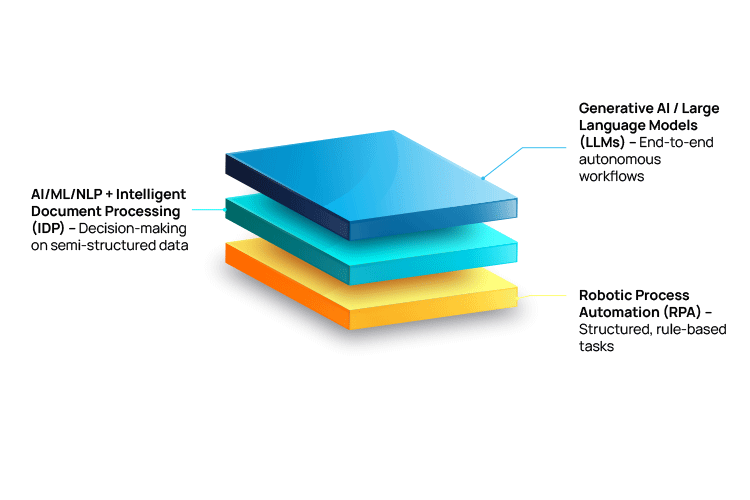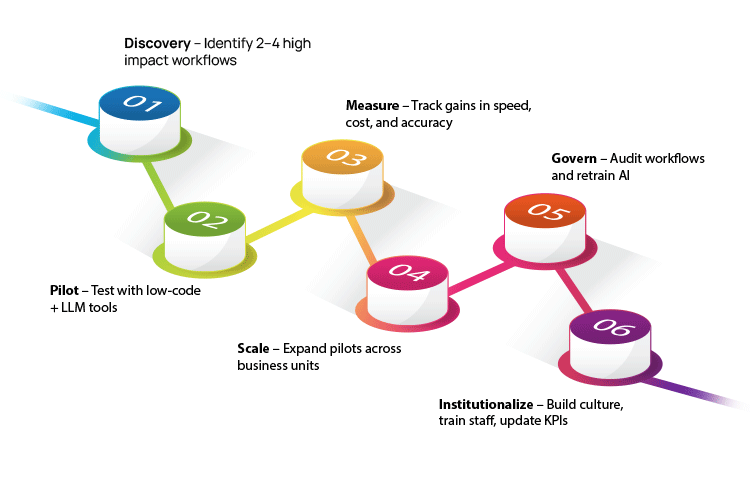

ACL Digital
5 Minutes read
Top 10 Strategic Insights CxOs Need to Know About Intelligent Workflow Automation Before Their Competitors Do
In today’s fiercely competitive landscape, adopting next-generation technologies is no longer optional—it’s critical for long-term viability. Intelligent Workflow Automation (IWA) is emerging as a transformative force, empowering organizations to elevate operational efficiency, enhance agility, and gain sustainable competitive advantage.
This blog shows 10 essential insights for CxOs to successfully deploy and scale intelligent workflow automation, turning automation from a technical initiative into a strategic growth lever that helps you outpace competitors using AI, automation, and integrated data systems.
1. Intelligent Workflow Automation Is a CxO Imperative—Not Just an IT Concern
Intelligent Workflow Automation (IWA) integrates Robotic Process Automation (RPA), Machine Learning (ML), Natural Language Processing (NLP), Intelligent Document Processing (IDP), and generative AI to drive enterprise transformation. According to Gartner, 60–70% of manual processes are primed for AI-powered automation.
Early adopters are realizing:
- Up to 70% cost reductions, compared to 20–30% with traditional automation
- Invoice-to-pay cycles cut from several days to under an hour
- Improved compliance and fewer processing errors
Delaying adoption means falling behind in agility, accuracy, and cost efficiency.

2. Understand the Intelligent Workflow Automation Maturity Spectrum
- RPA: Rule-based, ideal for structured, repetitive tasks
- Intelligent Process Automation (IPA): Combines AI/ML/NLP for decision-making and unstructured data
- Agentic Automation: The frontier, leverages LLMs for end-to-end autonomous workflows
Case Study: ACL Digital helped a global consulting firm reduce monthly bank reconciliation time from 45 days to just 5 by integrating RPA with intelligent OCR and ML, achieving a 300% efficiency boost and eliminating legacy tool dependencies. Read more here.
3. Prioritize the Right Foundations
- Process Mapping & Strategic Discovery
- Identify high-volume, repetitive processes: invoicing, data entry, and email triage
- Focus on workflows with measurable ROI: claims, accounts payable, HR onboarding
- Platform Capabilities
Your tech stack should include:
- RPA + ML/NLP + IDP
- Human-in-the-loop workflows
- LLMs for natural language orchestration
- APIs and data lakes for seamless integration
- Operational Risk & Compliance Readiness
Embed safeguards into automated workflows:
- Secure APIs and access controls
- Automate compliance checks (e.g., KYC, SOX)
- Set up failovers and exception handling
- Conduct periodic audits for stability and accuracy
- Talent & Change Management
- Shift roles to bot supervision, data analysis, and oversight
- Build cross-functional squads blending tech, business, and change leadership
4. Focus on High-Value Use Cases for Rapid ROI
| Use Case | Business Impact |
| Expense & Invoice Processing | 80% faster cycle times, fewer errors, complete audit trails |
| Claims & Compliance | Automated validation reduces fraud risk and manual checks |
| Conversational Support | AI agents resolve ~70% of tier-1 tickets |
| DevOps Orchestration | LLMs accelerate incident response and resolution |
| Supply Chain Insight | Agentic workflows detect disruptions and reroute inventory |
These outcomes are achievable with integrated platforms like ACL Digital’s intelligent automation systems.
5. Follow a Pragmatic Roadmap
- Discovery: Identify 2–4 high-impact workflows
- Pilot: Use low-code tools and LLMs to test
- Measure: Track improvements in cost, accuracy, and speed
- Scale: Expand successful pilots enterprise-wide
- Govern & Improve: Routinely audit workflows and retrain AI models
- Institutionalize: Create “automation champions,” update KPIs, and foster buy-in

6. Prepare for Common Roadblocks
- Data silos & quality issues: Start with API integration and data unification
- Talent shortages: Upskill internally and partner strategically
- Cultural resistance: Emphasize a “co-pilot” model, not replacement
- Premature scaling: Prove value with focused pilots before expanding
7. Turning Competitive Benchmarking into a Strategic Advantage
Instead of treating benchmarking as a basic comparison tool, CxOs should use it as a strategic lens to drive smarter, faster, and more future-ready automation decisions. The goal is not to imitate competitors, but to identify gaps, anticipate trends, and leap ahead.
Dissecting the Automation Edge: What to Watch in Competitors
- Measure momentum in addition to maturity. How quickly are competitors scaling their automation efforts?
- Evaluate the depth of integration. Are they aligning automation with business KPIs and core workflows?
- Analyze the sophistication of their use cases. Beyond basic tasks, what high-value areas are being automated?
- Study their ecosystem strategy. Which platforms, vendors, and technologies are part of their automation stack?
- Anticipate their future moves. How are they preparing for agentic automation, AI governance, and ESG alignment?
Actionable Tip: Create a competitive automation scorecard to benchmark your enterprise regularly, and use it to shape a forward-looking, advantage-focused automation strategy.
8. Build a Responsible AI Governance Framework
As AI scales across workflows, governance becomes essential. CxOs should ensure automation is:
- Explainable: Outputs must be transparent and business-readable.
- Privacy-compliant: Align with GDPR and industry-specific standards.
- Bias-aware: Regular audits to detect and address model bias.
- Human-supervised: Maintain ethical oversight with human-in-the-loop systems.
Establish a governance charter involving IT, Legal, and Executive teams for regular review.
9. Make Intelligent Workflow Automation Part of the Core Strategy
To fully realize its benefits, Intelligent Workflow Automation must be embedded in the broader enterprise strategy:
- Align with KPIs: Whether improving NPS, accelerating cash flow, or reducing cycle times.
- Integrate with digital transformation: Cloud migration, data modernization, and CX improvements.
- Drive executive sponsorship: Involve CIOs, COOs, CHROs, and CFOs early.
- Continuously benchmark: Leverage peer insights, analyst reports, and vendor roadmaps.
Strategic execution builds resilience, agility, and a competitive moat.
10. Don’t Just Automate. Continuously Optimize.
Automation is not a one-time fix. Leading organizations treat intelligent workflow automation as a living system. They rely on real-time analytics, feedback loops, and AI monitoring to refine workflows, improve efficiency, and stay aligned with changing business needs. CxOs must embed a culture of continuous optimization into their digital transformation strategy to unlock long-term value.
Could you please add this as the final point and update the numbering across the blog accordingly?
Let me know if you need any further input from my side.
Conclusion: Lead the Future of Work—Today
Intelligent Workflow Automation isn’t just another technology trend—it’s a fundamental shift in how businesses operate. CxOs who lead with vision, institutionalize responsible AI, and embed automation into their strategy will outpace competitors on speed, cost, and innovation.
Those who wait will be forced to catch up in a market that rewards first movers. Now is the time to act decisively, partner with automation leaders like ACL Digital, and transform Intelligent Workflow Automation into a powerful engine for growth and innovation.
Sources
- https://cxotoday.com/specials/what-ceos-need-to-know-before-investing-in-ai-for-logistics/
- https://www.ibm.com/cloud/smartpapers/cxo-guide/
- https://www.automationanywhere.com/company/blog/thought-leadership/cxo-series-tips-implementing-generative-ai-accenture
- https://www.persistent.com/blogs/a-cxo-strategy-toolkit-for-a-successful-intelligent-automation-hyperautomation-journey/
Related Insights


The AI Developer’s Guide to Data Formats: TOON vs. JSON and Beyond


Matter Protocol: Powering the Smart Infrastructure of Future Cities

AI-Powered Personalization – How Devices Learn, Adapt, and Anticipate You

